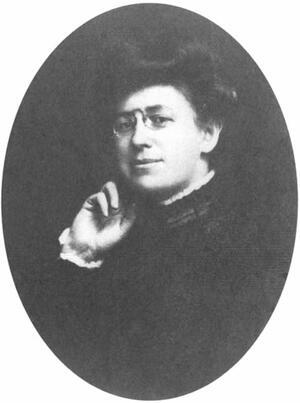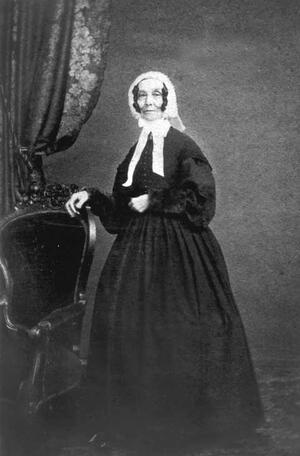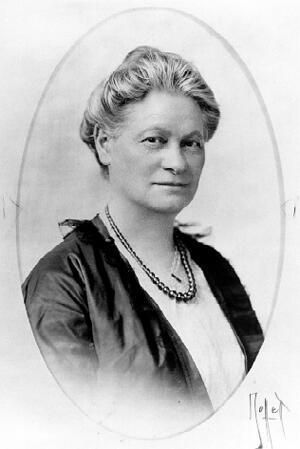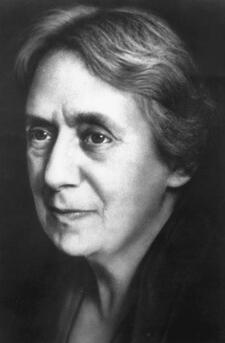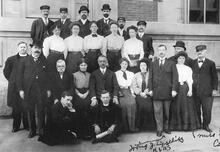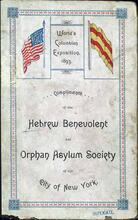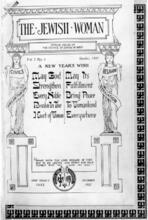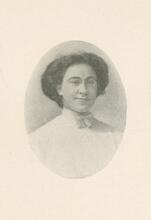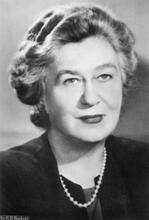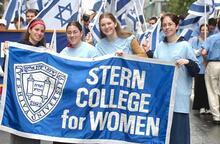Philanthropy in the United States
A suffragist who encouraged newly enfranchised women to go to the polls together to avoid harassment, Pauline Perlmutter Steinem was the first woman elected to the Toledo Board of Education. Her legacy of social activism can be seen in her granddaughter, Gloria Steinem.
Institution: The Jacob Rader Marcus Center of the American Jewish Archives, Cincinnati, OH, www.americanjewisharchives.org and the Toledo-Lucas County Public Library
Since the first Jews arrived in the seventeenth century, women have played central roles in American Jewish communal life. For many generations, Jewish women’s philanthropy generally occurred through autonomous women’s organizations, women’s organizations that included some men, and women’s auxiliaries of male-dominated groups. Although the forms and nature of their participation have changed, their contributions have always been critical in creating new organizations and initiating new programs, ranging from benevolent societies, Sunday schools, and tuberculosis sanitoria to health and human services in Israel and Birthright/Taglit. Once primarily involved in single-gender organizations, Jewish women are now taking their place in Jewish communal life in ways unforeseen in the past.
Introduction
Jewish law and custom, secular culture, institutional arrangements in the broader society, and gender roles have shaped Jewish women’s involvement in philanthropic activities. Although the term is often associated with the beneficence of the wealthy, philanthropy refers to giving time as well as money to charitable and community organizations.
Jewish tradition specifies that both men and women are obligated to perform acts of hesed [loving-kindness] and zedakah [social justice]. These are mitzvot—religious obligations—that specify the importance of visiting the sick; preparing the dead for burial; comforting mourners; donating money to the poor and the needy, especially widows and orphans; offering hospitality; supporting religious institutions; and providing brides with dowries. These actions are both individual and communal obligations.
There are qualitative differences in the ways that men and women have fulfilled these obligations at different times and in different contexts. Under strict interpretation of Jewish law, which governed most Jewish communities until the nineteenth century, Jewish women were not obligated to the same standards of ritual performance as men or expected to devote significant amounts of time to learning Jewish texts. Consequently, philanthropy has long been a principal vehicle for religious expression for Jewish women. Involvement in philanthropic endeavors also provided Jewish women with a separate sphere, an arena in which they could contribute to community life, often serving as a context for exercising influence in the larger community or society. In social settings where few Jewish women had paid jobs, philanthropic work provided them with “invisible careers.”
Over the course of American Jewish history, there has been a fusion of Jewish tradition and American values in the evolution of a culture of American Jewish philanthropy. Jewish philanthropy has been a unifying force in an otherwise geographically and religiously diverse community.
Jonathan Woocher outlines the evolution and contours of an American Jewish “civil religion” that animates giving and volunteering. Key ideas include the interdependence and unity of the Jewish people, the importance of Jewish survival, the primacy of supporting the State of Israel, and tolerance of the community’s denominational diversity. Since the 1970s, a complex shift has occurred in American Jewish life: a turn toward individual spirituality, a growth in nondenominational congregations, combined with an incorporation of religious practices in Jewish communal life. This shift is most apparent in the fact that the annual General Assembly of the Jewish Federations of North American now features Sabbathshabbat observance. Whereas in the mid-twentieth century donations to Jewish organizations functioned as a kind of “communal tax,” today the use of the terms zedakah and tikkun olam (to heal the world) have become much more prominent. Tikkun olam is also often used to justify donations to non-Jewish causes and to underscore that Jews have an obligation to promote social justice.
Histories of Jewish philanthropy during the nineteenth and twentieth centuries focus on the activities of middle-class Jews of European origin and their descendants, including most of North and South American Jewry.Ashkenazi women. There is limited information on Descendants of the Jews who lived in Spain and Portugal before the explusion of 1492; primarily Jews of N. Africa, Italy, the Middle East and the Balkans.Sephardi and Lit. "Eastern." Jew from Arab or Muslim country.Mizrahi women. These histories describe three types of organizations: autonomous women’s organizations, women’s organizations that included some men, and women’s auxiliaries of male-dominated groups. This article presents examples of these types of organizations and describes how recent trends in Jewish philanthropy and changes in gender roles have influenced contemporary styles of Jewish women’s philanthropy.
Autonomous Women’s Organizations
Beginning in the early nineteenth century, American Jewish women began to establish ladies’ benevolent societies. These organizations provided a social and economic safety net before organized Hebrew charities expanded toward the end of the century. The first of its kind, the Female Hebrew Benevolent Society (FHBS), was established in 1819 by members of Congregation Mikveh Israel in Philadelphia, including Rebecca Gratz. The group provided food, fuel, clothing, and other material goods. Over time, its services expanded to include nursing and medical care, travelers aid, and an employment bureau.
As the Secretary of the FHBS, Gratz lobbied for the establishment of the Hebrew Sunday School Society and became its first Superintendent from 1838 until 1863. Along with other members and with Isaac Leeser of Congregation Mikveh Israel, in 1855 Gratz was also instrumental in establishing the Jewish Foster Home, which served children from throughout the nation.
As the American Jewish population grew and organized Jewish charities began to provide many of the services once the sole province of benevolent societies, a number of national women’s organizations were established. Like the earlier benevolent societies, they continued to provide charitable services and fostered what is currently described as “Jewish continuity.”
The first national Jewish women’s organization was the United Order of True Sisters (UOTS), established in 1846. In contrast to most extant groups, which were local and drew their members from individual congregations, the UOTS was open to women from different congregations. It had an informal relationship with B’nai B’rith, the men’s fraternal order founded three years earlier. The organizations attracted members from the same social circles, middle-class and elite men and women of German and Central European origin. In 1874, B’nai B’rith made a commitment not to develop women’s auxiliaries, a commitment it reversed by the end of the century.
Like B’nai B’rith and other fraternal groups, the UOTS combined mutual benefit and charitable activities. Prospective members needed to be recommended and be approved by current members. Initially, members were eligible for sickness and burial benefits; health insurance was added in the twentieth century. Individual chapters donated funds to a variety of Jewish and secular causes.
The UOTS pioneered the active involvement of Jewish women in the public sphere, a strategy that became more common over time. Its relatively small membership was concentrated in Northeastern cities like New York, Philadelphia, Albany, and New Haven. After a peak membership of 24,000 in 1911, it declined to half that size when Rebekah Kohut studied the group in the early 1930s. The organization continued to exist until the early 2000s on a small scale.
Echoing a trend in the broader society, the number of national women’s organizations increased in the late nineteenth and early twentieth centuries. These organizations gave women a political voice both before and after they were able to vote. The first organization, the National Council of Jewish Women (NCJW), was founded in 1893. Like most other women’s organizations since then, the NCJW combined two major functions: the charitable work of benevolent societies and the public and the civic concerns of women’s clubs in the broader society. In its early years, NCJW members were especially concerned about the social and economic fate of young immigrant women. Much of its work focused on providing assistance to immigrants, especially those who landed on Ellis Island. Over time, individual sections selected a varied set of projects, including Sabbath schools, Jewish study groups, visiting hospitalized patients, and establishing Term used for ritually untainted food according to the laws of Kashrut (Jewish dietary laws).kosher kitchens and synagogues in hospitals and one of the first senior citizen centers in the United States. The Cleveland section sponsored a Council Educational Alliance, modelled after the Educational Alliance on the Lower East Side, as well as a residence for working women and a camp providing children with a “fresh air” experience in the summer.
By the 1920s, the growth of Jewish women’s organizations benefitted from upward mobility within the Jewish community that allowed more women to move out of the paid labor force. The rise of large, autonomous organizations in the early twentieth century occurred at a historical moment when more Jewish women were able to spend time volunteering. This process was amplified and expanded after World War II, when many families achieved greater economic prosperity and moved to the suburbs.
Hadassah, the largest Jewish women’s organization in the United States, was founded by Henrietta Szold in 1912 to raise money for health and medical care in Palestine. By the 1930s, Hadassah was a major sponsor of health care, social services, and vocational training, most notably Youth Lit. "ascent." A "calling up" to the Torah during its reading in the synagogue.Aliyah, the resettlement of Jewish children from Europe during and after World War II. It built hospitals throughout the country during the Mandate period and established playgrounds, clinics, and an important service that continues under government auspices, Tipat Halav (a drop of milk), which provides maternal and child health services. Hadassah hospitals and clinics continue to be important sources of health and social services in the State of Israel. Like the NCJW, Hadassah promoted active civic engagement and lobbying for both domestic matters and support for Israel. The membership rose sharply in the post-World War II period, from 15,000 in 1925 to over 300,000 in the 1950s.
With an increasing commitment to Zionism and a rise in migration to Palestine, a number of other organizations were established during the 1920s, including American Mizrachi Women (now AMIT, founded in 1925), Pioneer Women (1925), and the Women’s League for Israel (1928).
![AMIT-1 - still image [media] AMIT-1 - still image [media]](/sites/default/files/styles/scale_width_500px/public/mediaobjects/AMIT-1.jpg?itok=guPVI9HO)
Before, during and immediately after World War II, AMIT (then known as Mizrachi Women's Organization of America) was at the forefront of Youth Aliyah, the rescue of Jewish children from Europe and their resettlement in Palestine. Pictured here is the AMIT Youth Village at Petah Tikvah, today the AMIT Kfar Blatt Youth Village and Mishpachton. This group of children were photographed in 1948.
Institution: AMIT Archives
A different ideology and constellation of functions were evident in the Emma Lazarus Federation of Jewish Women’s Clubs. This organization, founded by Clara Lemlich Shavelson, a union activist, mobilized women who were interested in expressing their progressive ideology on domestic political issues in a Jewish context. Joyce Antler observes that the clubs “developed an agenda for collective action that linked women’s rights and human rights to historical models.”
The influx of immigrants in the early twentieth century contributed to the establishment of nineteen free loan societies established by women. These societies were especially critical at a time when it was difficult if not impossible for women to obtain credit. The Ladies’ Hebrew Free Loan Society of Providence only lent money to women, but in other cities, such as Seattle and Chicago, both men and women were able to obtain credit from women’s free loan societies.
Women’s Organizations that Included Some Men
A second pattern of organizational arrangements consisted of Jewish women’s groups that included some male donors and participants, often because men had the organizational skills that the women lacked.
Isaac Rontch and the Yiddish Writer’s Group surveyed home-town societies [landsmanschaftn] during the 1930s in a Work Projects Administration–supported project. A small number of the 2500 landsmanschaftn that responded to a survey were “ladies’ societies”: 71 were founded by women and 287 were women’s auxiliaries. A majority of the women’s landsmanschaftn had male presidents or secretaries. For example, the Proskurover Ladies Benevolent Society was founded in 1909 and incorporated in 1916 by five women and one man. A 1938 composite photograph of the officers and board members of the United Wilner Ladies Relief featured 40 women, including the author’s grandmother, plus five men whose responsibilities were not listed.
These mutual benefit societies provided a context for sociability, sponsoring numerous social functions. They also provided immigrants with social and economic capital, as well as welfare benefits including interest-free loans, burial plots, funeral expenses, and sickness and disability benefits. Like free loan societies, they had an enormous impact on the social and economic mobility of immigrants and were important building blocks in the development of viable Jewish communities.
Some women’s organizations recruited men as a way to sustain an enterprise that needed more money or organizational expertise. The Philadelphia Jewish Foster Home, established in 1855, and the Brooklyn Ladies Hebrew Home for the Aged, founded in Williamsburg in 1907, were established by women but found that they needed to recruit men as donors and board members. Adding male members saved the Hebrew Technical School for Girls in Manhattan from bankruptcy. Philadelphia’s Ezrath Nashim [Helping Women], founded in 1873, was reorganized as the Jewish Maternity Home and expanded its activities to personal visiting, a sewing circle to produce clothing and other items, a Nurses’ Training School, a seaside Home for Invalid Women and Children, and a temporary nursery. The inclusion of men did not lead to male dominance since, according to Evelyn Bodek, “The men added to the Board but never controlled the society.”
Women’s Auxiliaries
A third type of organizational arrangement is the women’s division of a larger, male-dominated organization. These ranged from synagogue-based benevolent societies that evolved into sisterhoods; the Women’s Divisions of local federations and of national or international groups like B’nai B’rith, the American Jewish Congress, ORT, and the United Jewish Appeal (UJA). In these auxiliaries, women carried out charitable and communal work without necessarily being included in the organization’s power structure. Some organizations, like local Federations, included women on their boards, but in other cases, like the UJA, women were expressly excluded as late as the end of the 1970s, in what Amy Stone called “the locked cabinet.”
The earliest auxiliary type of organization was the synagogue-based benevolent society. Women in Congregation Sheareth Israel in New York formed the Hebrew Benevolent Society in 1820. Similar groups were established before the Civil War in other New York City congregations like B’nai Jeshurun, Shaarei Tefillah, and Temple Emanuel. In Atlanta, whose Jewish community developed later, the Atlanta Hebrew Ladies’ Benevolent Society was established in 1870 as part of the city’s major Reform synagogue. As a rule, these groups provided food, coal, clothing, and financial assistance, cooking lessons, temporary housing, cash assistance, and help with medical and maternity care. According to Idana Goldberg, they were also concerned with religious practices and ensured that their services conformed to Jewish traditions.
As the American Jewish population increased exponentially in the last several decades of the nineteenth century, these important but modest efforts became insufficient and there was a growth in the number and range of institutions like orphanages, hospitals, and old age homes. There were also efforts to promote coordination and consolidation with the development of centralized Jewish charities in cities such as Chicago (1859), Philadelphia (1869), and New York (1874). This innovation was influenced by the idea of “scientific philanthropy,” the need for efficiency, and the application of business principles to charitable endeavors. Many individual charities merged into these larger entities, while other small charities remained autonomous. This effort accelerated with the creation of local Federations in Boston and New York that carried out one major fundraising campaign for all of their members based on the premise that one joint campaign was more efficient and effective.
With the increase in immigration and the Jewish population, organized charities took on many of the functions previously performed by women’s benevolent groups. Some benevolent societies evolved into Sisterhoods of Personal Service, synagogue-based organizations that coordinated their work with larger charitable entities. In New York City, these sisterhoods were assigned districts within the city and provided “friendly visitors” to the clients of Jewish charities, offering instruction, guidance, and financial assistance. The first of these was established at New York’s Temple Emanuel in 1889. By 1919, there were 24 throughout the country. In New York City, several sisterhoods recruited volunteer “friendly visitors” for the United Hebrew Charities. Much of this effort involved German Jewish women who aimed to Americanize the growing population of Eastern European immigrants.
At Shearith Israel, the Spanish and Portuguese synagogue, the sisterhood established an Oriental Committee to serve the small and impoverished population of Descendants of the Jews who lived in Spain and Portugal before the explusion of 1492; primarily Jews of N. Africa, Italy, the Middle East and the Balkans.Sephardic immigrants from Greece and Turkey living on the Lower East Side. It distributed relief to those needing financial assistance and referred families to the United Hebrew Charities. The Committee sponsored an employment bureau, a religious school, and a settlement house, called Neighborhood House, which included a synagogue and the Jewish Friendship Circle for young people. Members also arranged dramatic performances and celebrations like an Independence Day event in 1912.
Although many of these efforts continued, the relationship between the Sisterhoods of Personal Service and the United Hebrew Charities in New York ended once the UHC was superseded by the Federation of Jewish Philanthropies. Individual sisterhoods reduced their benevolent activities and turned their attention toward serving their congregations rather than the community at large. They spent time raising money, organizing social events, supporting Hebrew schools, and establishing gift shops that raised money but also encouraged members to make use of the ritual objects and books they sold.
Women’s auxiliaries played an important role in many of the Jewish orphanages and children’s institutions established during the second half of the nineteenth century. At the Rochester Jewish Children’s Home, a Mother’s Club of neighborhood women prepared a Lit. "sanctification." Prayer recited over a cup of wine at the onset of the Sabbath or Festival.Kiddush for each Lit. "son of the commandment." A boy who has reached legal-religious maturity and is now obligated to fulfill the commandmentsbar mitzvah and provided each child with clothing, including new outfits for major Jewish holidays. The Hebrew Orphan Asylum in New York City had a Godmothers’ Association whose volunteers served as mentors and confidants for children who benefitted from exposure to cultural institutions. Visits to the women’s families gave them “a taste of family life.”
In some instances, auxiliaries initiated significant institutional changes. Women’s divisions raised funds for dormitories at Yeshiva University, Hebrew Union College, and the Jewish Theological Seminary. The expansion of kashrut (kosher) supervision by the Orthodox Union occurred in the early 1920s at the initiative of the Women’s Division led by Mrs. Rebecca Goldstein, the daughter of a major philanthropist and the wife of a prominent rabbi. Goldstein harnessed the efforts of sisterhood members to increase the availability of food products under kosher supervision.
In 1933, Louise Waterman Wise, the wife of a leading Reform rabbi, founded the Women’s Division of the American Jewish Congress. Two of its early actions directly addressed anti-Semitism: a challenge to Catholic women who supported Father Coughlin and support for a boycott of goods imported from Nazi Germany.
Joseph Papo’s description of the Women’s Division of the Central Sephardic Jewish Community of America is one of the rare discussions of the philanthropic activities of Sephardic women. During World War II, its members sold war bonds, recruited blood donors, sent food and packages to Sephardic soldiers, and knitted items for the Red Cross. After the war, they sent food and packages to Sephardic refugees and Holocaust survivors in Israel. As part of its commitment to caring for older persons, the group advocated for the establishment of the Sephardic Home for the Aged in Brooklyn. Even after the Central Community itself ceased to exist, the Women’s Division remained active until the late 1980s.
The Arbiter Ring (Workmen’s, now Worker’s, Circle) had a unique arrangement. Women were able to be members from its inception in 1892, although few women joined and actively participated. The organization allowed women to form their own chapters beginning in 1906, but they could not vote at national conventions. The chapters sponsored many of the same programs as women’s clubs, including lectures, drama clubs, and opportunities for civic and political engagement. They also challenged gender roles within the organization. In contrast to its socialist and egalitarian ideology, the organization initially adopted a patriarchal model of men as breadwinners and women as homemakers in fashioning its member benefits. The organization did not pay funeral costs to women whose husbands were not members and its sickness benefits excluded pregnancy. In addition to advocating for changes, the women’s chapters initiated and raised funds for its network of its Yiddish schools, camps, and social service programs.
Profound changes in American Jewish life, Jewish philanthropy, and women’s gender roles have significantly altered the style and substance of Jewish women’s civic engagement during the past half century. Both the structure and the culture of Jewish philanthropy have changed: there has been an efflorescence of new organizations and more funds flow from family foundations rather than from individual donors. The growth of family foundations echoes a trend in the general society and is also the product of greater affluence within Jewish communities.
The culture of Jewish philanthropy has also changed. Shaul Kellner points out that beginning in the 1970s, communal leaders began to realize that Jewish continuity was contingent on robust Jewish identities. As a result, Jewish organizations instituted practices that were more closely tied to Jewish traditions. They incorporate more Hebrew in their promotional material, provide Jewish learning opportunities for staff and lay leaders, and more often observe Kashruth at events and in their facilities. Many individuals and organizations adopt the discourse of tikkun olam (repair of the world) to promote giving to Jewish causes but also to progressive and social change endeavors.
Starting in the 1970s, women began to challenge the male-dominated power structure of Jewish communal organizations. More women completed college and possessed the kinds of professional skills which could be applied to their volunteer work. As a result, there have been significant changes in the styles and activities of Jewish women’s participation in the public sphere.
In contrast to earlier periods, Jewish women’s volunteering is far less concentrated in women’s organizations. Concern about a decline in active volunteering began in the 1950s. Mary McCune points out that the leadership of Cleveland’s NCJW “struggled to find committed volunteers for its many endeavors.” While women’s organizations continue to raise substantial amounts of money, they have fewer members. In response, several have modified their missions, admitted men, and underscored their feminist identity.
Organizations have responded to changes in gender roles in different ways. After B’nai B’rith began to admit women to individual chapters, not just women’s groups, the B’nai B’rith Women’s Organization became independent in 1990 and changed its name to Jewish Women International (JWI) in 1995. In contrast, Women’s American ORT, whose membership grew from 12,000 members in 1950 to close to 90,000 in 1970, merged with American ORT in 2007 to become ORT America.
Today Hadassah, NCJW, and JWI define themselves as feminist advocacy organizations that promote social change. They continue to raise funds to support hospitals and health care in Israel (Hadassah) and social service programs for women and children in the United States (NCJW). These three organizations describe their mission as empowering women to support feminist issues such as reproductive choice, women’s health, and domestic violence. They link this commitment to the Jewish values of social justice and tikkun olam.
The two major organizations for Orthodox women continue to be dominated by women, although men are eligible to join. AMIT and Emunah continue to support educational and social welfare services in Israel. Both fairly recently omitted the word “women” from their names. The Orthodox Union, the major organization for centrist and modern Orthodox Jews, has created a Women’s Initiative to expand women’s participation and leadership. An important development in the Hasidic community is Ezrat Nashim, a women’s ambulance service based in Boro Park in Brooklyn, that has challenged gender norms in order to provide women with an alternative to the male-only volunteer ambulance corp.
Two other types of organizations, often on a relatively small scale, operate in major Orthodox communities, continuing some of the efforts once performed by benevolent societies. Bikkur holim (visiting the sick) societies visit hospitalized patients, attend to their needs for ritual objects and kosher food, and provide housing for relatives. One of the largest bikkur cholim societies was founded by Feige Teitelbaum, wife of the leader of the Satmar Hasidim, and grew from a one-woman project to a major network of women who provide food, apartments, transportation, and other services to Jewish patients and their families. The Bikur Cholim of Manhattan also provides significant financial support for uncompensated medical care. Individuals and groups continue to operate free loan societies that lend or distribute goods. These “gemachim,” an acronym for gemilut hasadim (acts of kindness), primarily operate on a small scale, often in the founder’s home. They lend clothing for festive occasions, including bridal gowns, as well as ritual objects, baby supplies, tables and chairs, and myriad other types of goods.
Another important trend is the development of local women’s foundations in major centers of Jewish life, including New York, Atlanta, Miami and New Jersey. The women’s foundation in Washington. D.C., is, in fact, called the Tikkun Olam Women’s Foundation. These foundations are “giving circles”: members pool their donations and collectively decide where to donate the funds. In a similar vein, the Hadassah Foundation, NCJW, and Women of Reform Judaism also provide grants to feminist projects.
Women have also taken their place at the table as professionals, lay leaders, and donors. While mainstream Jewish organizations have been dominated by men, there were important exceptions in the past. Some were the major executives of women’s organizations like Sadie American of the NCJW. The National Jewish Hospital (NJH) in Denver was founded by Frances Wisebart Jacobs; Seraphine Pisko was central to its growth, serving as a fundraiser, key executive, and Executive Director of the NJH from the 1910s to 1938. Baroness Sophie Hirsch, a transnational philanthropist living in Paris, was a major donor supporting NCJW’s immigrant work and spearheaded the development of a combined residence and vocational training program for women that bore her name. Mary Fels of Philadelphia was critical in the early years of Hadassah. She donated 900 tons of food and medicine during World War I and the land on Mount Scopus for its medical school in the 1920s.
Women currently dominate the paid staff of many Jewish organizations, and more women are board members and substantial donors. Recent studies reveal that women comprise nearly two-thirds of the staff of Jewish organizations in the United States. Yet, at the same time, they continue to be underrepresented in top leadership positions limited by a “glass ceiling.” Parity with men’s compensation has yet to be achieved.
The role of individual women philanthropists has also increased. More family foundations are headed by the wives, widows, and daughters of benefactors. In contrast to the past, when women who were active in Jewish communal life did so at the helm of women’s organizations, there is a decided trend toward fashioning a volunteer career in a number of different organizations. This is the case for Brenda Brown Rever who founded the Baltimore Leadership School for Young Women and has been a leader in the Baltimore and national Federations, and Nicki Newman Tanner, a founder and board member of a broad range of Jewish and secular organizations, including the Jewish Women’s Archive and Hebrew Union College. Volunteer careers have also been combined with leading foundations, as is the case for Lee Hendler. Barbara Dobkin builds on her social work training and years of community participation in her role as a major supporter of feminist initiatives. Some women, such as Angelica Berrie and Jane Weitzman, draw on their business skills to shape their family foundations. Sally Gottesman combines three roles: she serves on several boards, makes funding decisions as a board member of her family’s foundation, and is a consultant to nonprofit organizations. All of these women continue a long tradition begun by Rebecca Gratz and Minnie Low of Chicago, who were both involved in Jewish and non-Jewish organizations.
Several women have been venture philanthropists. Mem Bernstein headed the Avi Chai Foundation until the end of 2019, when it closed its doors according to the wishes of her late husband. Avi Chai supported efforts to strengthen Jewish education and continuity, including research on Jewish schools, an Institute for school principals at Harvard University, and the creation of blended learning utilizing innovative technology in Jewish day schools. Lynn Schusterman of the Schusterman Family Philanthropies was an active partner in the creation of the Birthright/Taglit program and has a broad agenda supporting global causes including financial support for Hillel, BBYO, and programs dealing with gender and LGBT equality. The foundation is now led by her daughter.
Jewish organizations have also responded to calls for gender equity by appointing more women to their boards. More women are taking their place in these organizations based on their own talents and financial contributions, not primarily because of their husbands. In 1975, 17% of the board members of local federations were women. This increased to 25% in 1979, to 29% in 1986 and to 32% in 1993. In the 2018-2020 period, 43% of the board members of the Jewish Federations of North America were women.
A study sponsored by Ma’yan found that women comprised one quarter of the board members of 48 of the most important national Jewish organizations in the mid-1990s. This was about the same as general nonprofits in the United States. There was enormous variation, ranging from 62% for the Coalition for the Advancement of Jewish Education to 25% for the Union of American Hebrew Congregations (UAHC) and 2% for the Orthodox Union. In 2020, publicly available information for several of these organizations reveals some significant changes. For the Union for Reform Judaism (the former UAHC), 45% of board members are now women, as are 23% of the Orthodox Union’s. Just over one third (35%) of New York’s UJA Federation Board members are women.
The Ma’yan study provided additional details about the nature of women’s participation. Once they became involved, women were equally likely to be officers and serve on multiple boards as men. However, there was a distinct difference between women who were full-time volunteers and those who were working full time: the full-time volunteers more often served on multiple boards and defined themselves as influential compared to the women who had full-time jobs.
These studies reveal changing roles for women in Jewish philanthropy, both as leaders – paid and unpaid – and donors. While complete parity has not been achieved, especially for top leadership positions, there have been significant changes.
Conclusion
Women have played central roles in Jewish communal life in America since the first Jews arrived in the seventeenth century. Today, there is a greater range of options, since traditional women’s organization coexist with a broader range of opportunities as staff and lay leaders. While the forms and nature of their participation have changed, their contributions have always been critical in creating new organizations and initiating new programs, ranging from benevolent societies, Sunday schools, tuberculosis sanatoria, health and human services in Israel, and Birthright/Taglit. Once primarily involved in single-gender organizations, Jewish women are taking their place in Jewish communal life in ways unforeseen in the past. Perhaps the most significant change has been a shift from participation based on their membership in women’s organizations to a more freelance style of participation similar to the growth of paid labor in today’s “gig economy.”
Angel, Marc. “The Sephardim of the United States: An Exploratory Study. American Jewish Yearbook 13, 77-138, 1973.
Antler, Joyce. “Between Culture and Politics: The Emma Lazarus Federation of Jewish Women’s Clubs and the Promulgation of Women’s History, 1944–1989.” In U.S. History as Women’s History, edited by Linda Kerber and Alice Kessler-Harris. Chapel Hill, NC: University of North Carolina Pres, 1995.
Bernstein, Julia. “The Trend to Lend: Gemachim in Action.” Jerusalem Post March 12, 1993, p. 11.
Block, Debra S. Virtue Out of Necessity: A Study of Jewish Philanthropy in the United States, 1880-1918. PhD Diss., University of Pennsylvania, 1997.
Brautbar, Shirli. From Fashion to Politics: Hadassah and Jewish American Women in the Post World War II Era. Brighton, MA: Academic Studies Press, 2012.
Goldberg, Emma. “Orthodox Women in Ambulance Corps Challenge Traditions.” New York Times, April 19, 2021, p A14.
Grunfeld, Faigy. “The Role of Women in the Founding of OU Kosher.” Jewish Action Spring 2020. https://jewishaction.com/from-our-archives/from-our-archives-the-role-of-women-in-the-founding-of-ou-kosher/.
Herman, Felicia. “From Priestess to Hostess: Sisterhoods of Personal Service in New York City, 1887-1936.” In Women and American Judaism: Historical Perspectives, edited by Pamela S. Nadell and Jonathan D. Sarna, 148-181. Hanover, NH: Brandeis University Press., 2001.
Joselit, Jenna. “The Special Sphere of the Middle-Class American Jewish Woman: The Synagogue Sisterhood, 1890–1940.” In The American Synagogue: A Sanctuary Transformed, edited by Jack Wertheimer. Cambridge: Cambridge University Press, 1987.
Hammack, David C. “Jewish Philanthropy in Cleveland to 1990.” In Cleveland Jews and the Making of a Midwestern Community, edited by Sean Martin and John J. Grabowski, 35-57. New Brunswick, NJ: Rutgers University Press, 2020.
Horowitz, Bethamie, Pearl Buck and Charles Kadushin. The Roles of Women and Men on the Boards of Major American Jewish Organizations: A Research Report. New York: Graduate School and University Center of the City University of New York, November 1997.
Kelner, Shaul. “Religious Ambivalence in Jewish American Philanthropy.” Pp. 28-49 In Religion in Philanthropic Organizations: Family, Friend or Foe? edited by Thomas J. Davis. Bloomington: Indiana University Press, 2013.
Kliger, Hannah, ed. Jewish Hometown Associations and Family Circles in New York: The WPA Yiddish Writers’ Group Study. Bloomington, IN: Indiana University Press, 1992.
Kosmin, Barry A. The Status of Women in Lay and Professional Leadership Positions of Federations. New York: Council of Jewish Federations, 1994.
Levin, Marlin. It Takes a Dream: The Story of Hadassah. Jerusalem: Gefen Books, 2002.
McCune, Mary. “Creating a Place for Women in a Socialist Brotherhood: Class and Gender Politics in the Workmen’s Circle.” Feminist Studies 28, No. 3 (Autumn 2002): 585-610.
McCune, Mary. “She Will Be the Mary Poppins We Have Been Searching For: The Rise of Organizational Change in the Cleveland Section of the National Council of Jewish Women.” In Cleveland Jews and the Making of a Midwestern Community, edited by Sean Martin and John J. Grabowski, 122-141. New Brunswick, NJ: Rutgers University Press, 2020.
Milamed, Susan. “Proskurover Landsmanschaftn: A Case Study in Jewish Communal Development.” American Jewish History 76, No. 1 (September 1986): 40–55.
Nadell, Pamela S. America’s Jewish Women: A History from Colonial Times to Today. New York: W.W. Norton, 2019.
Papo, Joseph. Sephardim in Twentieth Century America: In Search of Community. San Jose, CA: Pele Yoetz Books, 1987.
Rogow, Faith. Gone to Another Meeting: The National Council of Jewish Women, 1893–1993. Tuscaloosa, AL: University of Alabama Press, 1993.
Saxe, Leonard and Barry Chazan, Ten Days of Birthright: A Journey in Young Adult Identity. Waltham, MA: Brandeis University Press, 2008.
Skolnick Einhorn, Deborah, Power of the Purse: Social Change in Jewish Women’s Philanthropy. PhD Dissertation, Brandeis University Press, 2011.
Tenenbaum, Shelly. A Credit to Their Community: Jewish Loan Societies in the United States, 1880–1945. Detroit: Wayne State University Press, 1993.
Wenger, Beth S. “Jewish Women of the Club: The Changing Public Role of Atlanta’s Jewish Women, 1870–1930. American Jewish History 76, No. 3 (March 1987): 311-333.
Werthheimer Jack. Giving Jewish: How Big Funders Have Transformed American Jewish Philanthropy. Avi Chai Foundation, March 2018. https://avichai.org/wp-content/uploads/2018/03/Giving-Jewish-Jack-Wertheimer.pdf
Woocher, Jonathan. Sacred Survival: The Civil Religion of America’s Jews. Bloomington, IN: Indiana University Press, 1986.

